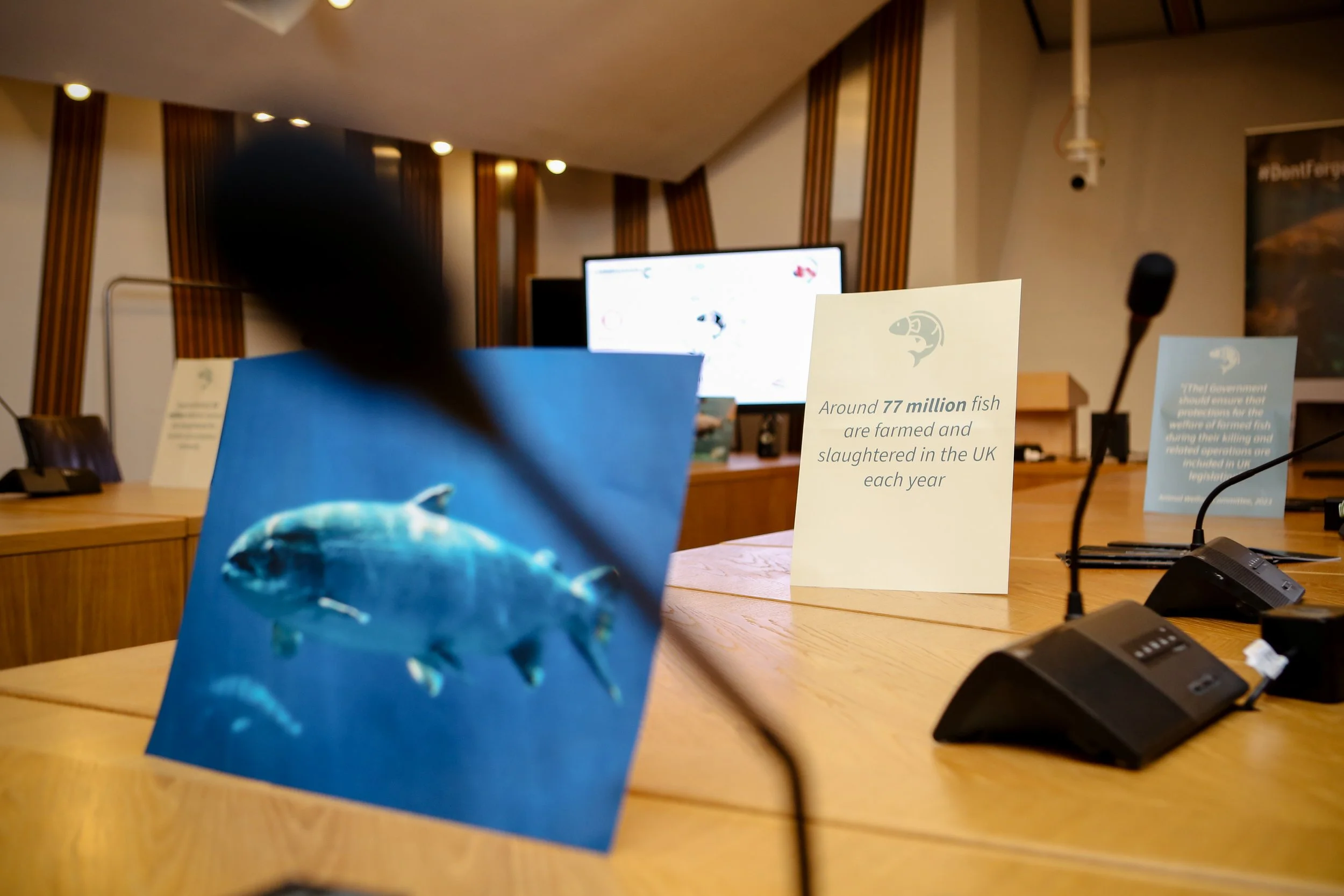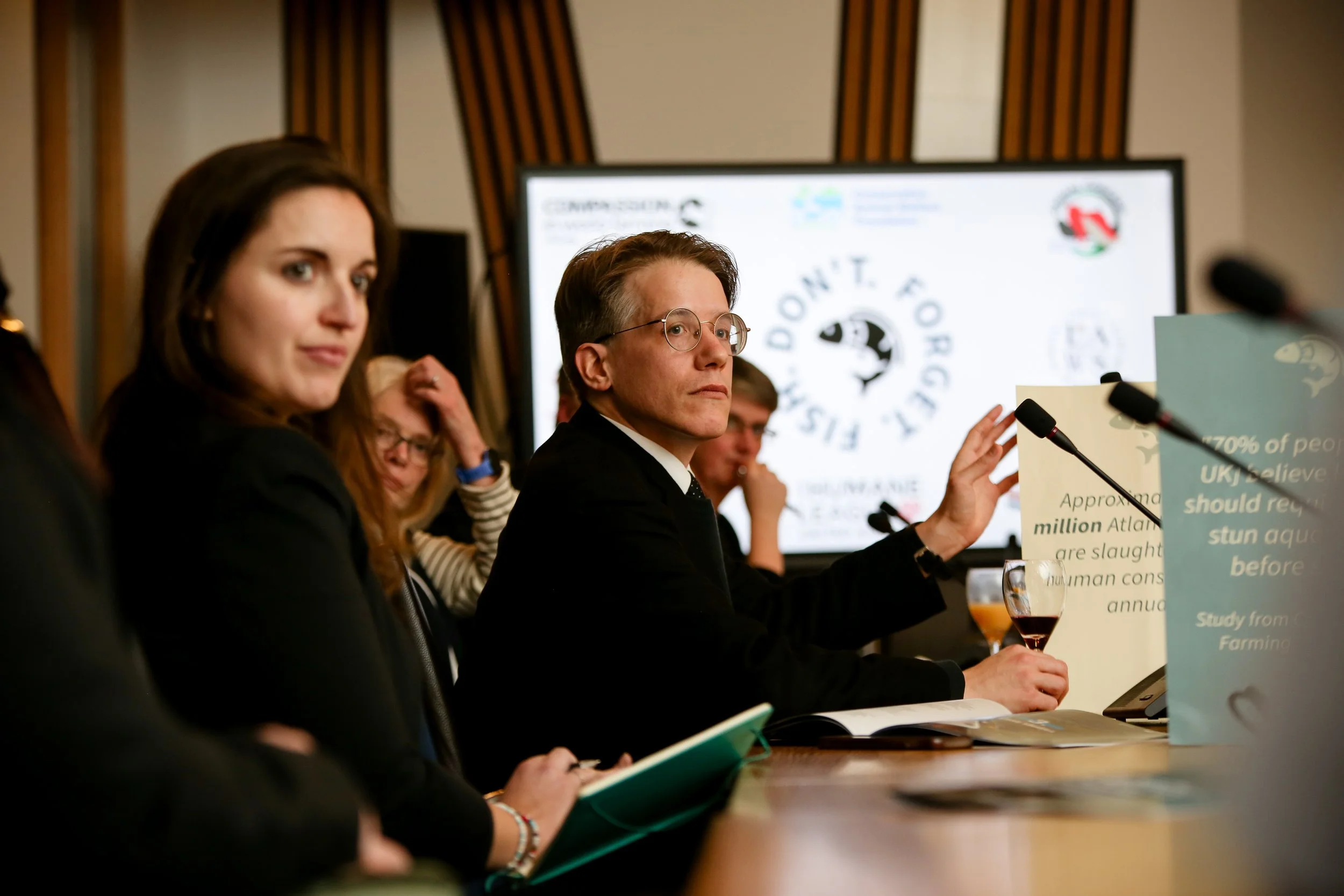
OFFISHIAL
GUIDANCE
FARMED FISH DESERVE OF🐟IAL GUIDANCE
Unlike terrestrial animals such as chickens and pigs, farmed fish in Scotland have not been provided with official guidance that adequately informs the industry how to comply with their legal obligations. Instead, the industry has relied on the industry-developed Code of Good Practice. Their Code of Good Practice is not legally binding, it also does not explain how to meet the legal obligations imposed on keepers. For years, The Animal Law Foundation has been concerned that this leaves room for confusion, with a risk of misinterpretation of the law and fish suffering. This changes now.
After years of calls from The Animal Law Foundation, in September 2025 the Scottish Government finally committed to introducing official guidance on fish welfare.
Why is official guidance needed?
In 2023, The Animal Welfare Committee (AWC) recommended species specific regulations for farmed fish at the time of slaughter, which we fully support. However, we see that it is also important that keepers of farmed fish know how to comply with their current legal obligations at every stage of the farming process, which is why we have been calling for official guidance on the welfare of farmed fish in their whole lifecycle.
In a letter to the Scottish Government, The Animal Law Foundation argued that relying on the Codes of Good Practice is insufficient as not only does it stay silent on welfare concerns such as killing methods, but numerous welfare concerns have been brought to light that breach the industry code and welfare law, yet despite the Scottish Government claiming breach of industry code can be used as evidence of an offence of welfare law, a freedom of information request revealed that there has never been a prosecution or formal notice issued to address farmed fish welfare concerns. It is unacceptable that despite numerous welfare violations, there has been no formal enforcement action taken by the government. We believe this is due to a lack of clarity.
What is official guidance?
Official guidance is a document issued by the government which will set out clear standards for how farmed fish should be cared for, spelling out what the law requires and how the industry must comply.
In January 2025, Holyrood’s Rural Affairs and Islands Committee published a report following its inquiry into salmon farming in Scotland and has recommended that the Scottish government should bring forward an Official Guidance to ensure welfare law is understood and enforced.
In May 2025, the Scottish Animal Welfare Commission (SAWC) also recommended that Official Guidance should be issued by the government.
In late September 2025 the Scottish Government committed to implementing official guidance for the welfare of farmed fish during their whole lifecycle
Our event at the Scottish Parliament
But our work does not stop here.
We will work to ensure the guidance is as robust and ambitious as possible.
LEGAL PROTECTIONS FOR FARMED FISH
Salmon is the most prolifically farmed fish in the UK. In Scotland it is estimated that 37.7 million farmed salmon are produced each year, leading Scotland to be the third largest salmon producer in the world. However, this number does not take into account all of the salmon that die prematurely before completing the production process (see section below).
Farmed fish are protected under welfare legislation in Scotland. The legislation includes The Animal Health and Welfare (Scotland) Act 2006, which prohibits farmed fish from experiencing unnecessary suffering and requires that the keeper of the fish must meet their welfare needs, such as a suitable environment. They are also protected under The Welfare of Animals at the Time of Killing (Scotland) Regulations 2012, which provides that animals are spared any avoidable pain, distress or suffering during their killing and related operations.
Despite these legal protections, a lack of official guidance explaining what they mean and how to meet them has created a plethora of confusion with industry unsure of what their legal responsibilities are. Instead the industry largely regulates itself via the Code of Good Practice. The Code of Good Practice claims to safeguard welfare, yet is silent on how to meet the specific legal requirements.
Multiple investigations on farms have revealed a range of health and welfare issues, such as disease, deformities, painful sea lice infestations and excruciating boredom from swimming endlessly in cramped, barren cages.
The Scottish government must ensure that official guidance is clear, robust and puts fish welfare at the forefront.
High Smolt Mortality Rates
37.7 million is the approximate number of fully grown salmon produced in Scotland each year, but what about the millions of fish that will not survive to reach harvest? To understand the depth of welfare concerns for farmed fish, it is imperative to do a deep dive into the entire farming process.
The life cycle of farmed salmon is divided into six stages. The first four stages take place in freshwater. In 2019 alone, 71.2 million ova were laid down to hatch in Scotland. Once the fish reach the fifth stage of development, they are classified as Smolt and transferred to seawater cages.
Alarmingly, 1 in 4 salmon produced from smolts do not survive to harvest. From the years 2013-2020, 48 million smolts were produced on average each year. During this time period, an average of 75.8 percent survive to reach harvest. These figures are just a snapshot of the millions of fish whose welfare is at risk when looking at the entire life cycle of farmed salmon.
Media Credit: Viva!
Smolt survival and production statistics from the Scottish Government 2022 Survey
DESERVING OF PROTECTION
Fish are intelligent, emotional animals that are recognised as sentient under the Animal Welfare (Sentience) Act 2022 - which means they can feel pain and suffer. Every last individual fish deserves the proper application of the law to protect them.
Join us in our mission to secure the welfare of farmed fish. Contact the Scottish Government urging it to implement official guidance that puts fish welfare first and ensures the legal protections that exist for fish are understood and applied in practice.






